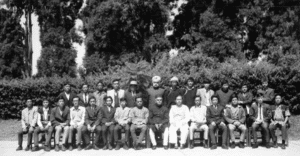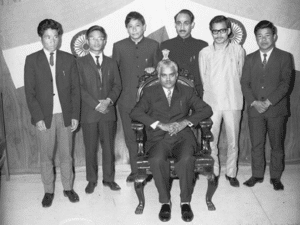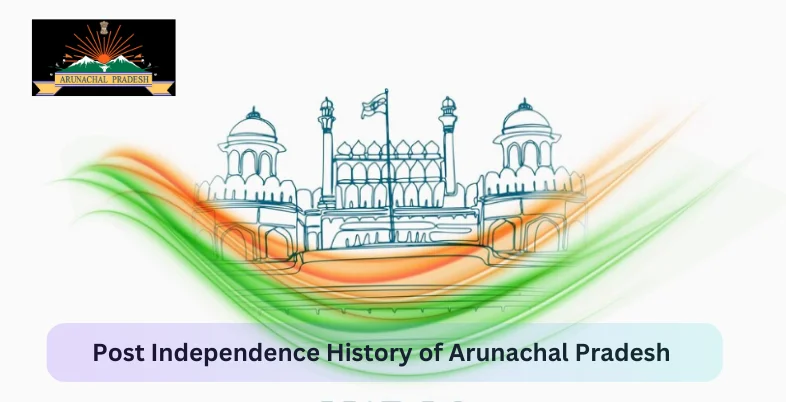- On 15th August 1947, India gained independence. Before leaving India, the British tried to separate the North East Frontier tract (NEFT) from the rest of India under the “Crowns Colony policy”, but the work of a few leaders such as Moje Riba, Rimo Riba, work of Daying Ering, Chow Khamoon Gohain and far sight-ness of Gopinath Bordoloi in mobilizing public opinion denounced the plan.
- The enactment of the constitution of India on 26th January 1950 brought all four NEFTs under the direct control of the Governor of Assam who would act as an agent of the President of India.
- Lt N.K. Rustomji ICS became the advisor for NEFT affairs.
Formation of North East Frontier Agency(NEFA)
- Till 1954 the NEFT affairs were under the Ministry of External Affairs, but by virtue of the North East Frontier Regulation (Administration) Act of 1954, the entire present Arunachal Pradesh and Naga Tribal area was renamed as “North East Frontier Agency” popularly NEFA.
- All the tracts in NEFT were renamed as Divisions in NEFA. Eg- The Balipara Frontier Tract renamed as Kameng Frontier Division, the Lakhimpur Frontier Tract renamed as Subansiri Frontier Division, the Abor Hill District renamed as Siang Frontier Division the Mishmi Hill District renamed as Lohit Frontier Division, and the Tirap Frontier Tract was renamed as Tirap Frontier Division.
- The Naga Tribal area was named Tuensang Frontier Division which was excluded from NEFA.
- Under the provision of the NEFA (Administration) Regulation Act of 1965, the frontier divisions were renamed Kameng District, Subansiri District, Siang District, Lohit District, and Tirap District with political officers known as the Deputy Commissioners.
Suggested Read👇🏻
Formation of Agency Council in 1969
- For the involvement of the people of NEFA in the policy-making mechanism, an apex advisory body known as the “Agency Council” was formed to advise the Governor of Assam on the affairs of NEFA.
- This was an elected body by the Zilla Parishad and hence the first Panchayati Raj Election took place in 1969.
- The first sitting of the Agency Council was held on 3rd December 1969 comprised 20 members and was inaugurated by Sri B.K. Nehru, the governor of Assam.
- Thus the policy-making power for NEFA went to the people of this state for the first time, though through an advisory body.
- The agency council was entrusted with functions which were almost corresponded to those of legislative assemblies of the states. The members of the agency council were:
- BK Nehru: The governor of Assam (chairman).
- Daying Ering: NEFA Member of Parliament.
- PN Luthra: Advisor to the governor of Assam.
- Wangmai Rajkumar: Vice president, Tirap Zilla Parishad.
- Khengman Longsam: Elected member, Tirap Zilla Parishad.
- Mowang Wangham: Elected member, Tirap Zilla Parishad.
- Hengwang Lowang: Elected member of Tirap zilla parishad.
- Ita Pulu: Vice President Lohit Zilla Parishad.
- Chewpak Gohain: Elected member of Lohit Zilla Parishad.
- Senge Kri: Elected member of Lohit Zilla Parishad.
- Gora Pertin: Elected member of Lohit Zilla Parishad.
- Todak Basar: Vice president, Siang Zilla Parishad.
- Kabang Borang: Elected member of Siang zilla parishad.
- Sutem Tasung: Elected member of Siang Zilla Parishad.
- Tamar Karlo: Elected member of Siang Zilla Parishad.
- Tapang Gyama: Vice president, Subansiri zilla parishad.
- Doni Kunya: Elected member of Subansiri Zilla Parishad.
- Nabam Rungkhi: Elected member of Subansiri Zilla Parishad.
- Gangte Taki: Elected member of Subansiri Zilla Parishad.
- Rinchin Namze: Vice president of Kameng Zilla Parishad.
- Tsewang Norbu: Elected member of Kameng Zilla Parishad.
- Prem Dorjee: Elected Member of Kameng Zilla Parishad.
- Naibili Dusisu: Elected member of Kameng Zilla Parishad.
- The third December 1969 will go down in the history of the administration as a red letter day for it marks the beginning of the exercise of statutory power by the people of the agency council to manage their internal affairs. It also provides a landmark in the constitutional growth of this territory. The members of the agency council who have met here today are, therefore, pioneers of a new phase of political advancement of their people.”
- The all-important and game changing decision to change the name of the NEFA to Arunachal Pradesh was taken during its second session at Shillong on 10 and 11 August 1970.
- The council had three alternatives for consideration, which were Arunachal, Udayachal, and Bramha Mandal.
- After a detailed discussion, the council unanimously resolved that the NEFA should be named Arunachal Pradesh – a land of rising sun.
- Another important resolution adopted was the introduction of an English medium of school education instead of an Assamese medium.
- The council unanimously resolved that English should be made the medium of instruction in education institutes of the NEFA.
- This was forwarded for the approval of the government of India.
- The council also unanimously decided that the member of parliament from the NEFA should be indirectly elected by the people of Arunachal Pradesh for the purpose of the 1972 elections, instead of being nominated by the government of India through the governor of Assam.
- The council also took up the resolution for opening up public schools and open schools across the NEFA.
NEFA BECOME ARUNACHAL PRADESH IN 1972
- The North Eastern Areas (reorganization) Act of 1971 separated NEFA from Assam.
- As a Union Territory, Arunachal Pradesh came into existence on 21st January 1972.
- The “Agency Council” became “Pradesh Council” headed by a Chief Commissioner.
- Mr KAA Raja was appointed as the Chief Commissioner.
- Consequent upon the election of Panchayat bodies in May’1972 the Pradesh Council was constituted by 26 members including 03 nominated members.
- The Capital of the state was also shifted from Shillong to Itanagar on 1st June 1974 which was inaugurated by V.V. Giri, President of India.
- The year 1975 was a watershed year for Arunachal Pradesh because the Pradesh Council was converted into a Provisional Legislative Assembly and a council of ministers was appointed for Arunachal Pradesh.
The Pradesh Council (1972-75)
- The North Eastern Areas (Reorganization) Act, 1971, amended Article 240 of the Constitution and provided for the creation of three states of Manipur, Meghalaya and Tripura, and two union territories of Arunachal Pradesh (formerly known as NEFA) and Mizoram. The NE Reorganization Act, of 1971 provided for renaming of the NEFA as Arunachal Pradesh as recommended by the Agency Council in its fourth session.
- The Act also provided for replacing the Agency Council with the Pradesh Council, at the top of the panchayat raj system which acted more or less like legislative assembly of other states.
- The newly constituted Pradesh Council was composed of the following members:
- Vice presidents of Zilla parishads who were also known as district vice presidents.
- Three representatives from each zilla parishad of five districts.
- Three members were nominated by the chief commissioner to represent such tribal communities who had not obtained any representative in the council.
- The two members of parliament from Arunachal Pradesh.
- The chief commissioner of Arunachal Pradesh.
- The Pradesh Council functioned like cabinet ministers and chief ministers of other states.
- There were five councillors representing each district with one chief councillor chosen from amongst themselves.
- The councilors were assigned various departments and the chief councilor was in charge of all the departments which were not assigned to any other councilor.
- The five councilors were:
- Prem Khandu Thungon, Chief Councillor.
- Wangpha Lowang, Councillor.
- Sobeng Tayeng, Councillor.
- Tamo Riba, Councillor.
- Tadar Tang, Councillor.
- The Pradesh Council had its first session on 1 August 1972.
- The Pradesh Council was converted into a provisional legislative assembly on 15 August 1975, and the chief councilor and four other councilors were sworn in as chief ministers and ministers on the same day.
- The members of the Pradesh Council became the members of the provisional legislative assembly.

A group photo of members of the Pradesh Council which was constituted on 1 August, 1972. The Pradesh Council was converted to a legislative assembly on 15 August 1975, and its members were re-designated as members of legislative assembly.

A group photo of chief councilor PK Thungon and four councilors, Tadar Tang, Wangpha Lowang, Tamo Riba, and Sobeng Tayeng with the then chief commissioner KAA Raja in 1972.
The Provisional Legislative Assembly (1975-1978)
- The Arunachal Pradesh Legislative Assembly was inaugurated on 15 August 1975 by Om Mehta, the then minister of state for home affairs.
- The post of the Chief Commissioner of Arunachal was upgraded to the post of Lieutenant Governor and KAA Raja, the then chief commissioner of Arunachal Pradesh, was sworn in as the first Lieutenant Governor of Arunachal Pradesh on 15 August 1975.
- The chief councillor was re-designated as chief minister and the councillors were given the status of ministers. Accordingly, the first council of ministers for Arunachal Pradesh was sworn in on 15 August 1975 in Itanagar.
- The ministry, headed by Prem Khandu Thungon, consisted of five members who were assigned to the following departments:
- Prem Khandu Thungon, Chief Minister: Finance, Home and Engineering.
- Tomo Riba, Minister: Agriculture, Horticulture, Animal Minister, Husbandry, Fisheries & Community Development.
- Wangpha Lowang, Minister: Education, Parliamentary Affairs, Panchayati Raj and Rehabilitation.
- Sobeng Tayeng, Minister: Supply & Transport Cooperative, Forest, Preservation of Wildlife and Industries.
- Tadar Tang, Minister: Health, Family Planning, Man Power, Planning and Statistics.
- Any subject which was not specified above was deemed to have been assigned to the chief minister.
- The first sitting of the first session of the Arunachal Pradesh Legislative Assembly was held on 18 August 1975 in Itanagar.
- KAA Raja, the first Lieutenant Governor of Arunachal Pradesh, addressed the first session of the Legislative Assembly.
- At the beginning of the session, Gora Pertin, the acting speaker, announced the results of the election of the speaker and the deputy speaker.
- Nokmey Nemati and Padi Yubbe were unanimously elected as the speaker and the deputy speaker of the assembly.
- The first general and direct election to the Arunachal Pradesh Legislative Assembly was held during March 1978.
- Consequently, with the passing of the Constitution 55th Amendment Act, Arunachal Pradesh finally attained full statehood on 20 February 1987.

